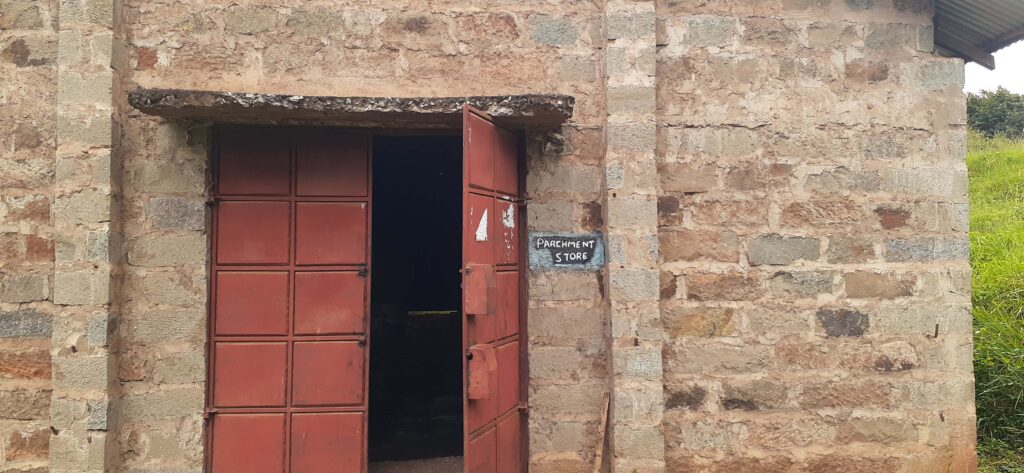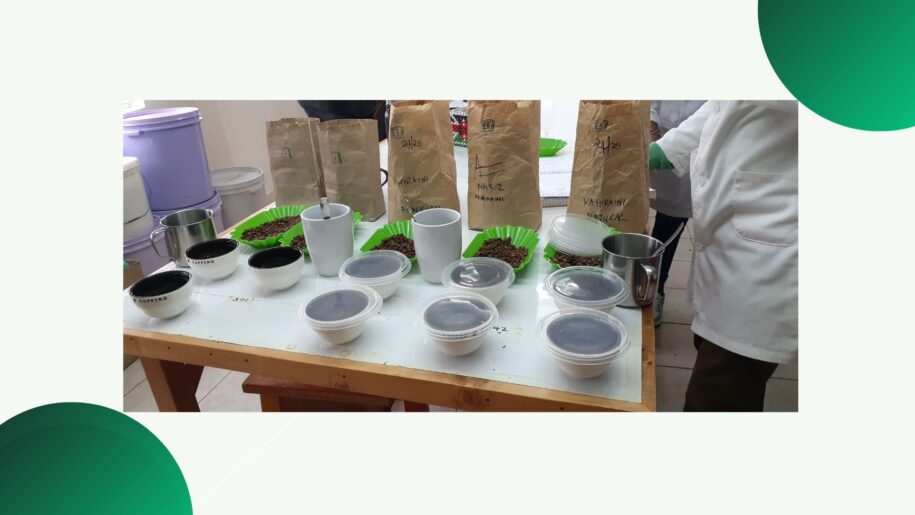Kahira-Ini Cooperative is situated in the Mathira region, renowned globally for its high-quality coffee, particularly in the Nyeri area of Kenya. This cooperative was once a significant part of the Giant Mathira Farmers Cooperative Society. Mathira FCS was in the ‘90s was one of the largest cooperatives in Kenya.
The cooperative’s secretary-manager, Mrs Wahito says, “It was a very big part of the giant Mathira farmers back then, we produced a lot of coffee and farmers were motivated.”
Kahira-Ini coop once comprised over 600 dedicated farmers at its peak. The cooperative was established as a vital component of the society’s capital development efforts, aimed at improving the livelihoods of local farmers and enhancing coffee production.
Historically, the cooperative consistently produced around 500,000 kilos of coffee annually, showcasing its impressive capacity and the commitment of its members. Their coffee scored highly and is still to this date regarded as one of the highest quality in the region.
One of the key features that contributed to this success was the presence of a modern pulping machine, which allowed for the efficient processing of coffee cherries right on-site. Additionally, the cooperative focused exclusively on processing washed coffees, a method known for producing a clean and bright flavor profile that is highly sought after in the specialty coffee market.
To support its operations, the cooperative utilized water pumped from a nearby river, ensuring that the pulping and washing processes could be carried out effectively. Access to clean water is essential for producing high-quality coffee, and this resource was crucial for maintaining the cooperative’s processing standards.
Overall, Kahira-Ini Cooperative played a vital role in the local coffee industry, emphasizing community collaboration and sustainable agricultural practices in one of the world’s prime coffee-producing regions.
Collapse of the cooperative.
In the 1990s, the coffee industry faced a significant downturn, leaving many communities in dire straits. The prices for coffee beans plummeted, drastically affecting the livelihoods of farmers who relied on this crop for their income.
Mrs Wahito continues, “When hard times struck, many farmers decided against coffee production because there were no returns. It is hard work but with very little pay, many found it difficult to continue.”
This price drop was not just a minor setback; it had profound implications for the agricultural landscape and the economy of entire regions. This shift in fortunes did not spare Kahiraini. As coffee prices fell, the returns on the hard work and dedication required to cultivate the coffee plants increasingly diminished.
Farmers, already burdened by the physical demands of their trade, found it increasingly challenging to justify the effort they poured into their fields. The impact on morale was there for all to see. Many farmers felt disheartened and disillusioned, which resulted in a significant decline in productivity.
Half of the KahiraIni cooperative’s members lost interest in maintaining their coffee farms, choosing to either abandon their crops or explore alternative sources of income that were more stable. Those who remained were few and far between, struggling to harvest meagre quantities of cherries.
The secretary-manager adds, “actually, this facility remained open but just as a collection center for the few kilos of cherries that were harvested by the few farmers who were still active. After collection, it was delivered to other washing stations for processing”.
This decline transformed what was once a vibrant community of coffee producers into a shadow of its former self. KahiraIni cooperative’s, once bustling hubs filled with the rich aroma of freshly harvested coffee, became nearly deserted and functioned primarily as collection center’s before delivery to other washing stations.
The remains of the past are still around, but they have lost their energy. The buildings themselves have become rundown and neglected. They were not taken care of regularly, and without people to look after them, many of them decayed. Some were treated even worse – they were damaged and robbed, while others were stripped for materials.

Old soaking tanks Kahiraini coffee society
In those harsh years, the spirit of the community was tested, and the very future of coffee cultivation in the region hung in the balance. The struggle was not merely about coffee; it was about the resilience of the farmers and their connection to a way of life that had sustained them for generations.
Picking up the pieces and reinventing the society.
In 2021, the chairman of the factory Mr Jack Ndirangu and Mrs Wahito who are very passionate about coffee and coffee production started the challenging task of revitalizing the once-thriving cooperative. They united and brainstormed tirelessly, eventually coming up with the idea of gradually reviving the coffee center.

Coffee cupping with Kahiraina Coffee Society
According to Jack, it was by the Grace of God that they were able to achieve a revival. “It is by His Grace that we achieved what we have now. It was a very difficult period, but thankfully, we are now on the right track”, Jack explains.
He adds, “Actually, the factory has collapsed on a couple of occasions. During the first time, there was a national collapse of the coffee sector, then it merged with other factories in the Mathira Coop society but now, we’re determined to succeed”.
With sustainability in mind, the members decided to explore the concept of naturally processed coffee, a new approach as the previous method only involved producing pulped coffee. An additional advantage of this method was that it required no water for processing, as the water pumps and pulping facilities were still not operational.
They picked up the pieces and successfully made it through the 2021/2022 season, gaining valuable experience and learning how to handle naturally processed coffee. With the help of well-wishers, the cooperative was able to pay the farmers a decent price for the delivered coffee cherries.

Kahiraina Coffee Society Parchment storage
This revival led to the return of former members, bringing the total up to 150, with more expressing interest in returning. Mrs Wahito explains, “When farmers realized that we were slowly reviving the society, they started returning and delivering some cherries. We are doing very well production-wise and it’s increasing. So far, we have over 70,000 kilos of cherries”.
The management realized the crucial importance of incorporating technology into their operations and, in 2023, they reached out to AGnimble to gain exposure to the international market and to digitize their operations. Through the AGnimble platform, the cooperative has been able to modernize its operations, offering hope for better times.
On the decision to incorporate technology into their operations, Jack says, “Adopting technology will help us build an equitable and sustainable cooperative. The world is going digital and I believe we are also due for an upgrade. It will make our operations much easier now and be able to access even more partners as we call our buyers”.
The cooperative plans to reintroduce Parchment and naturally processed coffee going forward, as the coffee produced in this region is still of the highest quality. A stable market and good clients are top priorities for the cooperative.
- Uganda Coffee Market Trends For The 1st Quarter of 2025 - May 15, 2025
- Sowing Seeds of Hope to Kahiraini Coffee Society - August 28, 2024
- The Next Wave of Coffee Producers - June 18, 2024
